How To Enable Audio Output Device In Windows 8
Z7_3054ICK0KGTE30AQO5O3KA30N0
hp-concentra-wrapper-portlet
![]() Actions
Actions
HP Desktop PCs - No Sound from the Speakers (Windows eight)
This document applies to HP and Compaq desktop computers with Windows 8.
The steps in this document describe how to troubleshoot and fix the problem when there is no audio coming from the speakers.
Before you begin: Restart the computer
If there is no audio coming from the audio device continued to your figurer, the consequence might exist acquired by an application controlling that device and preventing other applications from using information technology. Before attempting the other troubleshooting procedures in this document, restart your calculator, and so exam the sound to see if the trouble is fixed.
Step 1: Use the Troubleshooting tool
The Troubleshooting tool in Windows 8 can automatically fix mutual problems with your calculator, such equally audio recording. Although it may non fix every trouble, it is useful to run the Troubleshooting tool first earlier you manually right bug.
Picket a video on using the troubleshooting tool in Windows 8

To open the Troubleshooting tool:
-
Move the mouse pointer to the lower left corner of the screen, correct-click, then select Control Panel from the menu.
Figure : Control Console
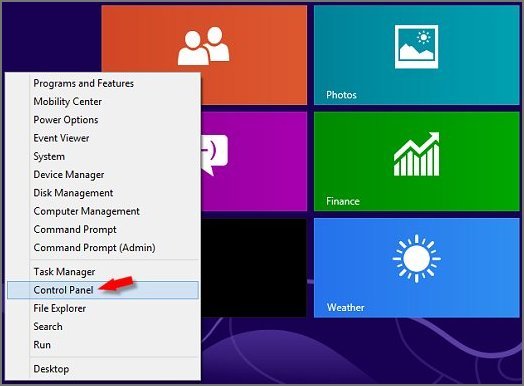
-
Under System and Security, click Find and fix problems.
Figure : Find and prepare issues
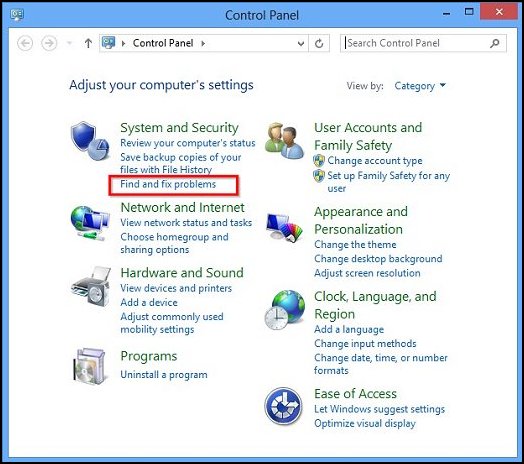
-
Click Hardware and Sound.
Effigy : Troubleshooting Hardware and Audio
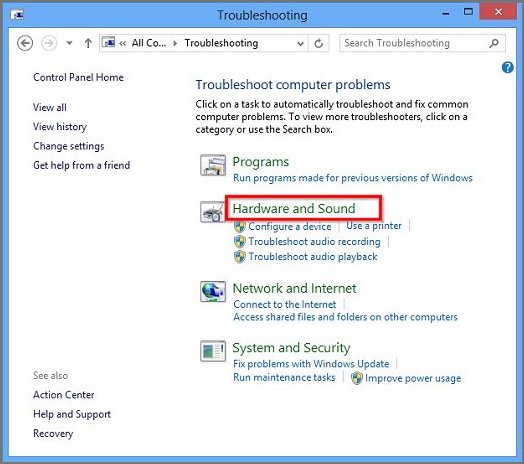
Troubleshooting audio recording and audio playback
-
Click Playing audio or Recording audio, and click Next.
Figure : Recording Audio
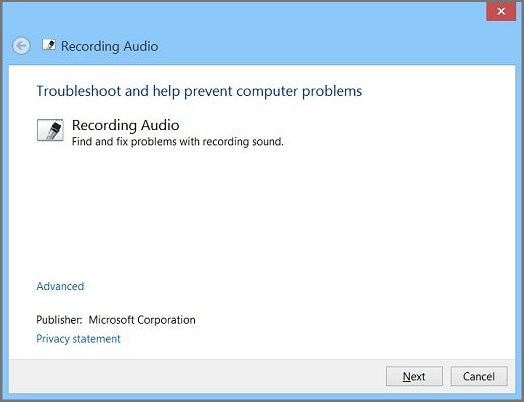
Figure : Playing Audio
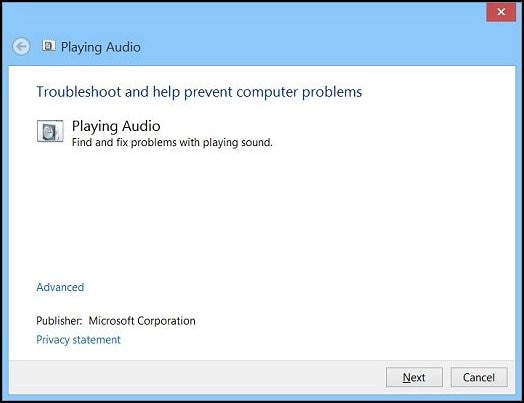
-
Select the device you desire to troubleshoot and click Side by side.
-
Wait while the troubleshooter detects problems and makes changes.
Effigy : Detecting bug

-
When the troubleshooter is done, the Troubleshooting has completed page displays listing whatever bug found and what changes were fabricated to the computer.
note:
For detailed information about the troubleshooting task, click View detailed information.
Click Close.
Figure : Troubleshooting completed

If a recommended action displays, select Apply this fix or Skip this step to continue to search for other bug. If your problem has not been resolved, check for sound from headphones.
Step ii: Bank check for audio from the headphones
Ii types of headphone connectors are bachelor on HP computers. I supports simply sound to the headphones, and the other supports audio to the headphones and the use of a microphone. The connectors are marked with symbols next them.
-
Connectors on the computer marked with a headset merely
 , support output sound only and piece of work with a standard iii-pin headphone or a iv-pin headphone, for sound.
, support output sound only and piece of work with a standard iii-pin headphone or a iv-pin headphone, for sound.Figure : Standard iii-pivot plug
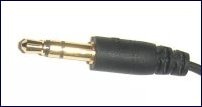
-
Connectors on the estimator marked with a headset with a microphone
 , support sound and the use of a microphone when used with a headset with a 4-pin plug and a microphone.
, support sound and the use of a microphone when used with a headset with a 4-pin plug and a microphone.Effigy : Four-pivot plug

To hear audio, either plug may be used with either connector. Using a iv-pin plug that is capable of supporting a microphone in a 3-pin connector allows sound to be heard, simply the microphone does not work because the computer's three-pin connector does not back up a microphone.
Step 3: Check volume and mute settings in Windows 8
The book setting for one or more than sound devices might be disabled or gear up too low. There are several things that can change sound volume: the volume control knob for your speakers or monitor, Windows book controls, and volume controls in sound software. If any of these volume controls are muted or prepare too depression, the entire sound feel is affected.
Watch a video on checking book and mute settings in Windows 8

-
If your powered speakers have a volume control knob, set it to halfway.
Figure : Book control knob for speakers (your speakers might be unlike)

If yous are using speakers that are built into your monitor, make sure sound is enabled for the monitor and volume is set up to halfway. Adjust the sound settings for your monitor by using the buttons on the monitor and/or the on-screen carte. To find more specific information most using and adjusting your monitor speaker settings, see the back up documentation that came with your monitor.
Figure : Volume and carte du jour buttons on a monitor (your monitor might exist different)

-
Move the mouse pointer to the lower left corner of the screen, right-click, and select Command Panel from the menu.
Effigy : Control Panel

-
Click Hardware and Sound. Nether Sound, click Adjust system book.
Figure : Conform system book
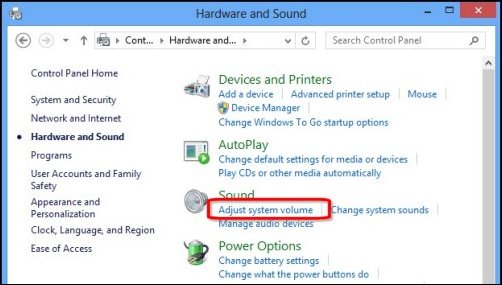
Figure : Volume Mixer
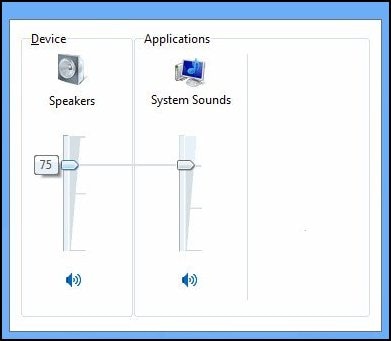
-
Make sure the volume is not muted by looking at the square Mute buttons below the volume slider. If the button displays a small carmine circle, the volume is muted.
If the volume is muted, click the Mute button to enable audio. The ruby circle on the speaker icon disappears when sound is no longer muted.
Audio muted
Sound not muted


-
Later verifying that the sound is not muted, elevate the volume adjuster up until it is at 75%.
-
To exam, click the book slider bar. If you hear a ding audio from all speakers, you are finished troubleshooting.
Effigy : Testing volume

If you still do non hear any audio, set the default speakers and test them.
Step 4: Set the default speakers and examination them in Windows eight
Use the following steps to set and examination the default speakers.
Lookout man a video on setting default speakers and testing sound in Windows 8

-
Move the mouse arrow to the lower left corner of the screen, right-click and then select Control Panel from the bill of fare.
Figure : Control Panel

-
Click Hardware and Sound, and then click Sound.
Figure : Audio Settings
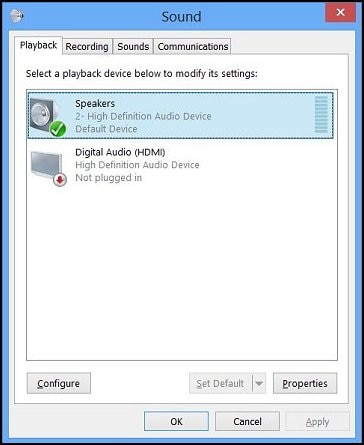
-
If headphones are connected and you are not using them as your main speakers, disconnect the headphones at present. Connecting headphones to the figurer mutes other speakers.
-
Find your connection type. If y'all take more than than i connectedness type, such as HDMI and Speakers, then choose the connexion type you desire to use.
Speakers

If you are using typical computer speakers or headphones (analog sound devices), make sure Speakers is selected. This is the most common sound setup for a desktop computer environment and includes many types of headphones, desktop speakers, 5.1 and 7.1 audio systems. Many monitors with built-in speakers as well back up a speaker connection using a divide audio cable continued from the computer to the monitor (not an HDMI connection).
Digital Output

If you want to transport all audio from the computer to digital speakers or a stereo digital device, brand sure the playback device labeled with Digital Output is selected.
HDMI

If your calculator has an HDMI connection and you are trying to use the speakers in a TV or monitor, brand sure the playback device labeled with HDMI is selected.
-
In the Audio window, select your Playback Device and click the Set Default push button.
Figure : Ready Default

-
With the default Playback Device selected, click the Configure push button.
-
Click your speaker setup in Audio channels.
Figure : Speaker Setup window with 5.ane Surround (5 speakers and a subwoofer) selected
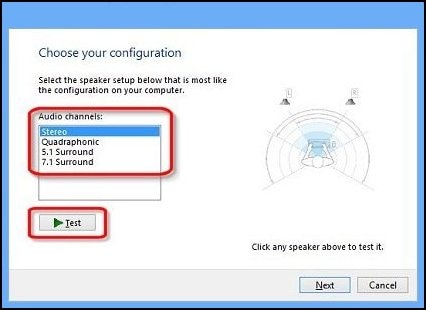
-
Click the Test button to send audio to each speaker, or click an individual speaker to ship sound to information technology.
-
If sound is heard correctly from each speaker, yous are finished.
If audio is missing from all or one of the speakers, or if the configuration type was changed, proceed with speaker setup by clicking Next. Follow the on-screen instructions to complete the speaker setup.
Play a audio. If sound problems go along, check the speaker connections.
Step 5: Bank check speaker connections in Windows 8
Use these steps to make sure you have the speaker cables continued to the correct sound connectors.
Scout a video on checking the speaker connections in Windows 8

-
Move the mouse arrow to the lower left corner of the screen, correct-click and and so select Control Panel from the menu.
-
Click Hardware and Sound, so click Sound.
Figure : Audio Settings

-
The Speaker Backdrop window contains a list of color-coded connectors that corresponds to each pair of speakers. Use this data to determine which connector goes with the speaker pairs that you lot are using.
Figure : Speaker Backdrop window for 7:i Surround setup

The example shown in the image is for a vii.one Environs setup, where:
-
L R (greenish, Line Out) is for the front left and right speaker pair (the green connector, normally labeled Line out).
-
RL RR (orangish) is for the Rear-left and Rear-correct speaker pair.
-
C Sub (black) is for the Centre or Subwoofer speaker.
-
SL SR (grayness), is for Side Left and Side Right speakers
-
-
Make sure each speaker cable is connected to its corresponding connector on the back of the estimator. The colors shown in the Speaker Properties window friction match the connector color on the computer.
-
If you have v.1 or greater speakers, connect the speaker cables to the speaker hardware (unremarkably on the subwoofer). And then lucifer the speaker cable to the connectors on the estimator using the colors shown in the Speakers Property window.
-
Play a sound. If yous yet do not hear any sound, check for sound from headphones.
Pace 6: Bank check for audio from headphones
If at that place is nonetheless no audio, bank check for sound output using headphones.
Watch a video on checking for sound from the headphones in Windows eight

-
Find and unplug all sound cables from the back of the computer.
-
Plug the headphones direct into the speaker out connector on the dorsum of the computer. The speaker out connector might have a symbol of a speaker or a circle with an pointer pointing out, or it might be labeled every bit OUT.
-
Examination for audio in Windows. Double-click the volume icon in the taskbar, and so click the book command slide in the Volume Mixer.
Figure : Testing volume

Each time you click the main book slide bar, you should hear a beep sound through the headphones.
-
If you hear sound through the headphones, the sound hardware on the computer is working, and the event is probably related to the speakers or speaker cables. Disconnect the headphones and reconnect the speakers.
When done, test again for sound using the same steps equally above with the volume command slider. If sound still does non work correctly later on reconnecting the speakers, try replacing the speaker cable (if possible), or speaker fuse and test once more.
-
If you cannot hear audio through the headphones, make sure that you are connecting the headphones into the correct connector, and endeavour again. If there is still no sound, go along to the side by side stride when you are sure the headphones are connected to the right audio connector on the back of the computer.
-
Microphone connector or Center/Subwoofer Out
-
Forepart speaker connector (to front powered speakers or headphones)
-
Line-in or Rear speaker Out
Figure : Figurer with 3 rear audio connectors

-
Side speaker out
-
Rear speaker out
-
Center and subwoofer out
-
Microphone
-
Line-out (to front end powered speakers or headphones)
-
Line-in
Figure : Calculator with six rear audio connectors

-
Step 7: Restore the audio driver in Windows eight
Audio files and settings that become changed can crusade sound bug. Restore the sound driver to reset audio settings for the sound hardware and reinitialize the sound configuration in Windows.
note:If the figurer was upgraded to Windows Vista before being upgraded to Windows 8, y'all might non be able to apply all the features of an integrated audio device that is compliant with Audio Codex '97 (Ac '97) specifications. To resolve this, update the audio driver. Encounter Step viii: Updating the audio driver.
To roll back to the previously installed driver through the Device Manager, complete the following steps.
Sentinel a video on restoring the audio driver in Windows viii

-
Move the mouse pointer to the lower left corner of the screen, right-click, select Device Manager from the carte du jour.
Effigy : Device Manager
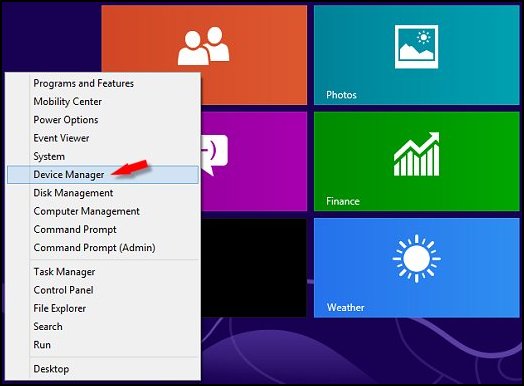
-
Double-click Sound, video and game controllers.
-
Right-click the name of the audio device and select Backdrop.
Figure : Device Director sound device properties
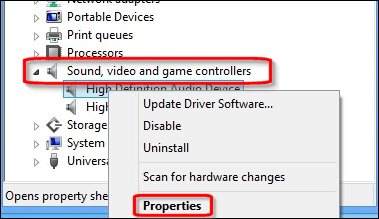
-
Click the Driver tab.
note:
Audio devices will vary depending on the configuration of your computer.
-
Click Roll Dorsum Driver.
Figure : Example sound device properties - The audio devices on your calculator may exist dissimilar.

-
Click Yes to coil back to the previous commuter.
-
Test for sound.
If in that location is withal no audio, update the audio driver.
Step eight: Update the audio driver
An updated audio commuter might resolve the problem if the estimator is experiencing audio problems after upgrading the operating system to Windows 8, or the computer is experiencing sound bug in a item software programme.
Updating the sound driver from the HP Spider web site
-
Go to the HP Customer Back up Web site and enter your product number. For example, p6230f or 600-1050uk.
-
Select Windows 8 for the version of Windows the reckoner is using.
-
Click the Driver - Audio link.
-
If an update is available from HP, follow the instructions on the download folio to download the commuter and install it.
-
Test for audio after installing the software.
-
If an audio update is not bachelor or the audio trouble persists after the update, update the audio commuter using Device Director.
Updating the audio commuter using Device Manager
Update the sound driver using Device Manager equally follows:
-
Movement the mouse arrow to the lower left corner of the screen, right-click, select Device Manager from the card.
-
Double-click Sound, video and game controllers.
Figure : Audio devices in Device Manager
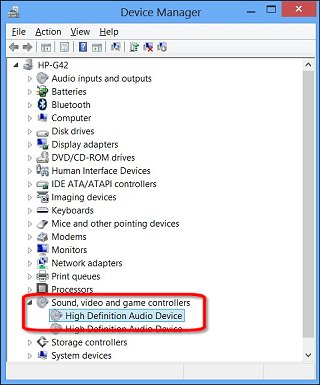
-
Right-click the name of the sound device listed nether Audio, video and game controllers.
-
Select Update Commuter Software.
Figure : Update Driver Software pick in Device Manager
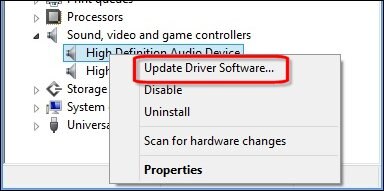
-
Click Search automatically for updated driver software.
Figure : How do you want to search for driver software
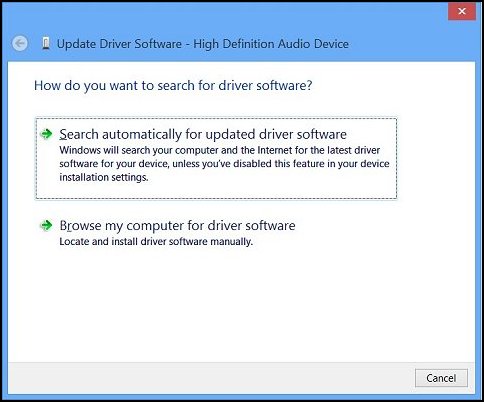
-
Windows checks for and installs any updated drivers institute. The Window displays whether the estimator already has the latest available commuter or if Windows was able to successfully update the audio driver.
Figure : Windows has successfully updated your driver software

-
If a window opens that asks you to restart the computer, restart the figurer.
-
If you cannot find a driver from HP, download and install an updated audio commuter bundle from the audio engineering provider.
note:
Your estimator probably uses Realtek Audio Codec, or Integrated Device Technology software. Download and install sound drivers from one of the following sites:
-
Integrated Device Applied science (IDT) Sound Products Spider web page (in English)
-
Realtek's Downloads Web page (in English)
-
Test for audio. If sound issues persist or no drivers could be found and installed, check Device Manager.
Step 9: Bank check Device Manager in Windows 8
If you cannot hear sound, check Device Manager to determine the state of the sound hardware.
Watch a video on checking Device Director in Windows 8

-
Move the mouse arrow to the lower left corner of the screen, right-click, select Device Manager from the card.
Figure : Device Director

-
Double-click Sound, video and game controllers.
-
Do the following, depending on what displays:
-
If a audio device is not listed and the computer uses a audio card, reseat the sound card into the motherboard slot. Go to the side by side step if bug continue.
-
If a sound device is listed with a down pointer, the device is disabled. Correct-click the sound device name and select Enable to re-enable the device. Get to the next step if problems keep afterward enabling the device.
Figure : Enabling a disabled sound device

-
If a sound device is listed, correct-click the device proper noun and select Backdrop to view more helpful troubleshooting information in the Device Condition window. If Device Condition shows that the device is working correctly, the problem is probably related to sound settings, the speakers, or the cables.
-
Footstep x: Run the Audio examination from the HP PC Hardware Diagnostics (UEFI)
The Hardware Diagnostics Audio Playback Exam checks your arrangement to brand certain the audio device is functioning properly and tests the functionality of the audio subsystem, including audio controllers and codecs.
Utilize the following steps to run the HP PC Hardware Diagnostics (UEFI) Audio Test. During the test, a few music notes are played in sequence and and so repeated. This test takes ane infinitesimal to consummate for each sound output port.
-
Concord the power button for at least five seconds to plough off the figurer.
-
Turn on the computer and immediately press the F2 key repeatedly, well-nigh one time every 2nd.
-
The HP PC Hardware Diagnostics (UEFI) main menu is displayed. Click Component Tests.
Figure : HP PC Hardware Diagnostics (UEFI) main card
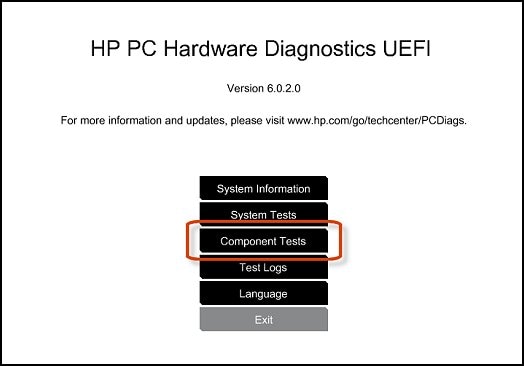
-
The Component Tests carte du jour displays. Click Audio.
Figure : Component Test bill of fare with Sound selected

-
Click Run in one case to start the test.
Effigy : Sound Playback Test

-
Select Speaker to brainstorm the test.
Figure : Testing the Speaker
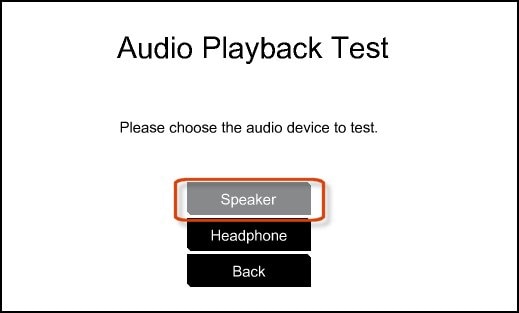
-
During the test, a few music notes volition be played in sequence and repeatedly. Mind advisedly and select the number of notes yous hear in the sequence. If you enter a tone number incorrectly, run the test again. If you hear zero, select No sound.
annotation:
Some HP models have a Volume control in the examination window. Make sure y'all increase the volume level earlier you brand a music tone choice.
Figure : Inbound the number of notes
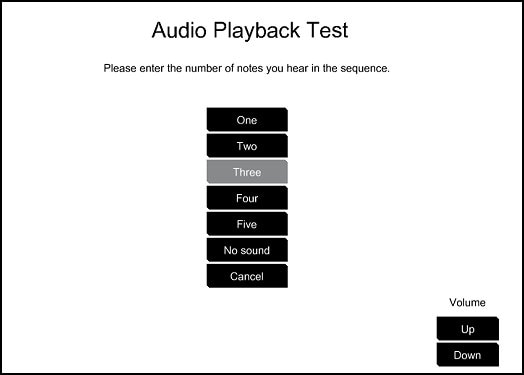
-
When the Audio Test is consummate, the results are displayed on the screen.
If the audio test passes, return to the Main menu to get out and restart the calculator.
If the audio fails the tests, a failure ID volition exist provided. Write downwards the information so yous have it available when you lot contact HP Customer Support. The information is also available in the Test Logs, on the Diagnostics UEFI main page.
Effigy : Sound examination results

-
Step xi: Inspect speaker hardware (ability, speakers, and fuses)
Cheque the speakers to see if the power cord is connected and that the speakers are receiving power.
Many powered speakers, particularly speaker systems with subwoofers, have fuses. If there is no sound coming from the speaker, not fifty-fifty a humming racket, remove and supercede the fuse. Even if you lot do non recall that the fuse has blown, information technology is a good thought to swap the fuse to make sure. If the fuse is notwithstanding good, you have a fill-in fuse.
-
Turn off ability to the subwoofer and unplug power to the speakers.
-
Remove the fuse embrace then the fuse, and wait through the drinking glass cylinder. If the wire inside is separated, has night spots, or burn marks, replace the fuse. If the fuse looks good, bandy the fuse anyway and go on the older fuse as a spare.
-
Buy a new fuse. Information technology is a expert thought to have the onetime fuse to the electronics store when purchasing the new fuse. This manner, the old fuse tin can be used to brand certain it matches the new fuse purchased at the store.
-
Install the new fuse, replace the fuse cap, apply power, turn the speakers on, and test for audio.
To forbid impairment to the speakers and to forestall fuses from blowing in the future, keep the following items in mind when using the computer:
-
Turn off the speaker book control before applying ability to the speakers.
-
Like a high-quality home stereo system, it is not good to heighten the volume more than half the range of the control knob. Doing so reduces the quality of the sound and is harder on the speakers. Poor sound quality occurs when lower sound levels are raised to a peak level. Lots of audio occurring at one acme level stresses the speakers.
Play a audio. If sound issues go along, test the sound hardware using HP Support Assistant.
Source: https://support.hp.com/id-en/document/c03515411
Posted by: munozfrapter.blogspot.com

0 Response to "How To Enable Audio Output Device In Windows 8"
Post a Comment